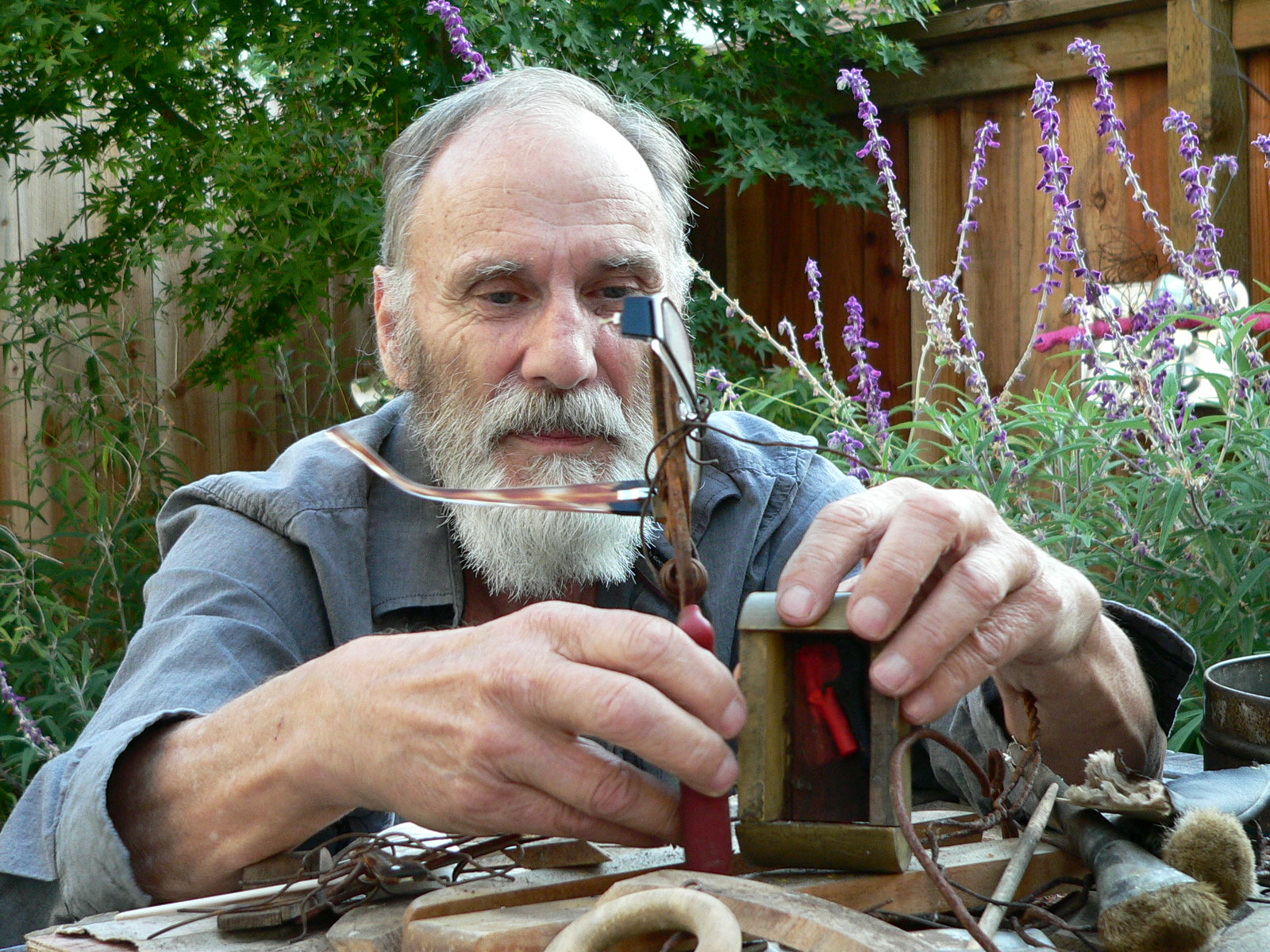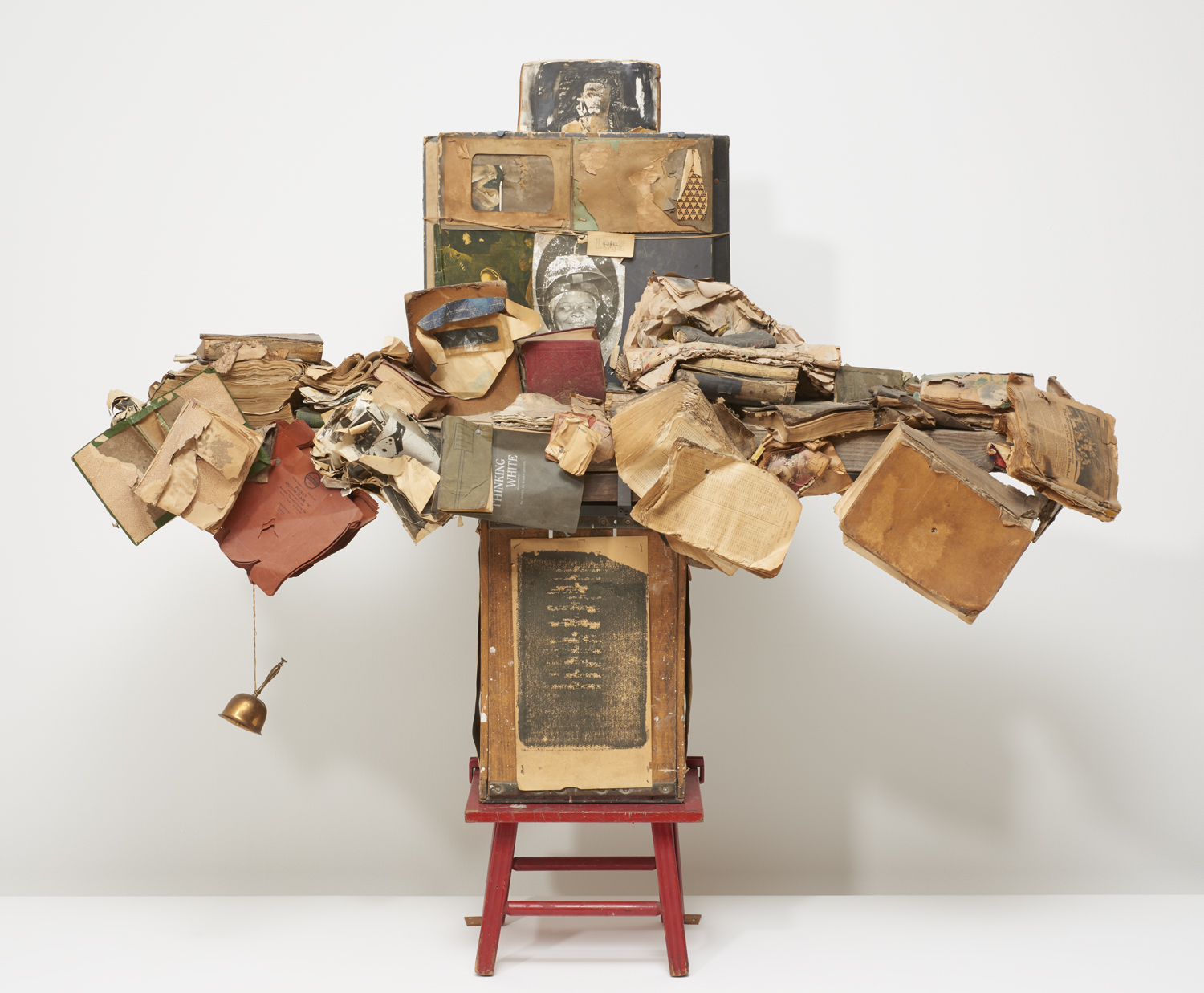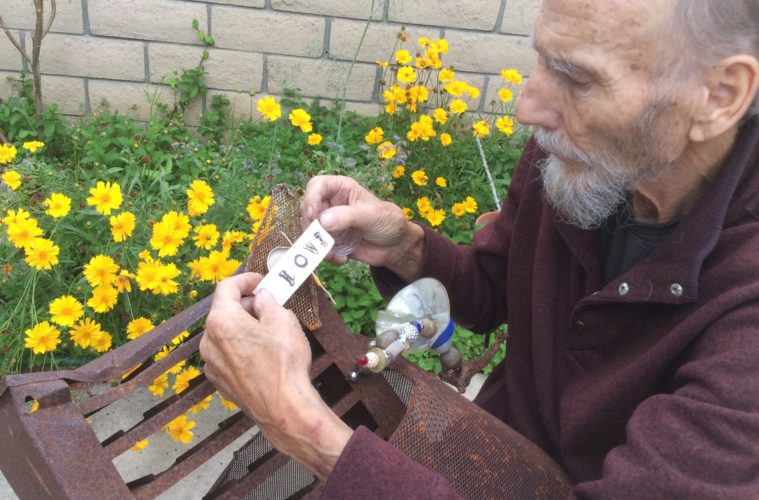It was 2011, and a high point for Irvine-based artist George Herms as he had just installed the exhibition, “Chaos’ Job: Restrain Order” at Santa Ana’s Grand Central Art Center. Representing the breadth and depth of his six-decade career, the show contained artworks made from cast-off materials, including a rusted ironing board, a wheelbarrow, lawn mower, muffin tin, fan, early cell phone, broken mirrors, torn crumpled posters, miniature cars, lamp bases, broken plastic bowls filled with rusted tools, and numerous other junk.

George Herms
When asked if he created these art pieces with intention or randomly, he responded, “The inanimate objects tell me what to do.” He titled the pieces in this nuanced show, “Trifed Nebula” and “Golden Globe of Amber,” among other names, while his artist’s statement consisted of black squiggles on white paper. The completed assemblage pieces illustrated Herms’ lifelong penchant for creating artworks that defy description, which elicit surprise and amazement from viewers. One might describe him as a trickster or a person who delights in eschewing normal behavior to open people’s minds to a larger worldview.
Herms is a pioneer of “West Coast Assemblage Art,” or sculptures made from found and discarded materials, a style popularized in the 1950s and ’60s. While he has exhibited his work in major galleries and museums worldwide, he modestly refers to his work as “junk sculpture.”
Another major passion is listening to mid-20th century jazz. He is quoted as saying, “The feeling I get when leaving a jazz club is how I want people to feel when they leave an exhibition of mine.” With jazz riffs infused into his life, he similarly regards his entire life as one of harmonious flow, not as one that has proceeded in stages. He explains, “I never went to art school, I don’t like categories, and my two enemies are tradition and impossible.”
The story of Herms’ life is one of impressive achievements and accolades, with many of them fueled by his relationships with women. “Women have nurtured me my entire life,” he explains, “from my grandmother, to my mother, to my wives” and now to Sue Henger, who he lives with and who inspires and encourages him on a daily basis. “Real creativity comes from women, he adds. “Men are jealous as we can’t make babies. So we make art.” He is also the father of four children, grandfather to three and great grandfather to one child, all wonderful, successful children, he says.
Herms, who was born in 1935 in Woodland, California, recalls playing an artist in a school play at age 5. But he was more interested in the sciences as he grew up. The high achiever entered UC Berkeley in 1955, studying engineering. He stayed there for only a short time, as his real interests soon became poetry, art and jazz. “I had the heart of a poet,” he says. But he gave up writing verse early on, quoting from John Keats to explain why: “If poetry comes not as naturally as the leaves to a tree, it had better not come at all.”

The Librarian, 1960 – George Herms – Courtesy Norton Simon Museum
After leaving Berkeley, Herms traveled to Mexico where he spent six months, “searching for my soul.” He then moved to Los Angles and soon after met Wallace Berman, an assemblage artist and filmmaker, and Robert Alexander, a poet and printer. Both men were associated with the nascent beat movement, a life style and perspective that Herms naturally embraced. He soon after moved to Topanga Canyon, where Berman and Alexander were residing (and where he maintained a studio for decades), and with the mentoring of these artists, he began to seriously create assemblage art.
In 1957, Herms mounted his first solo show, “Secret Exhibition” in Hermosa Beach. The Getty Foundation blog explains, “It was installed among the foundation blocks of a row of demolished buildings in Hermosa Beach, California. Visited by only a handful of friends on a single day, the works were then abandoned to the elements and left to decay.” During that year, he also spent six months in prison for possessing a small amount of marijuana. “I learned a lot about crime while I was there,” he says. While he never returned to prison, Herms has undoubtedly folded the knowledge acquired behind bars into art pieces. “Artists use everything they have, every minute of the day,” he explains.

Tribute to Tony Delap – George Herms
One of his early artworks, and among his most well-known, “The Librarian” (1960), is composed of a wooden box, numerous pieces of scattered papers and books and a loving cup, all presented on a painted stool. This now iconic artwork, displayed in the Getty Center’s 2011-12 “Crosscurrents in L.A. Painting and Sculpture” exhibition, conveyed a scholar’s or obsessive collector’s inability to part with papers. In 1961, his work was exhibited in the Museum of Modern Art’s “The Art of Assemblage” exhibition, which included art pieces by Picasso, Braque, Duchamp and other seminal artists of that period.
Herms has continued to create groundbreaking and often-mystifying assemblage pieces over the decades, along with drawings and sets for the theater and opera. His evolving career has afforded him exhibitions at the Museum of Contemporary Art, and the Los Angeles County Museum of Art, in L.A.; the Whitney Museum of American Art, and the Museum of Modern Art, in NYC; and The Museum of Fine Arts, Houston. He has received fellowships from the National Endowment for the Art, a John Simon Guggenheim Fellowship in Sculpture, the Prix de Rome Fellowship in Sculpture, among others.
Among his other important achievements was inspiring Cal State Fullerton students to create the Orange County Center for Contemporary Art in Santa Ana in 1980. Serendipitously, the opening of a 2016 Herms exhibition, “Pipe Dreams,” at that venue exemplified his live and let live attitude. At that event, a woman backed into one of his junk sculptures, and accidentally knocked it down, shattering one quarter of it. To the then stunned silence in the venue, the gallery manager swept the broken sculpture parts off the floor, stood the piece up, and asked Herms to inspect it. He determined that his sculpture was just fine in its newly configured state.
Herms is currently working on a “theater piece,” titled “Moten Swing,” or a poster-like illustration paying homage to the recently deceased Tony DeLap. The illustration, based on early 20th-century “Dada” art archetypes, uses alphabet letters as visual elements. It will be presented at UC Irvine this November.
Summing up his joyously nonconformist, multi-faceted life, George Herms says, “I get up every day and make something I’ve never seen before.”
Advertising disclosure: We may receive compensation for some of the links in our stories. Thank you for supporting Irvine Weekly and our advertisers.

